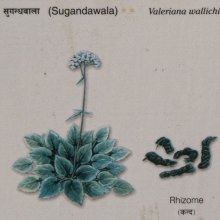Valeriana wallichii: 1 definition
Introduction:
Valeriana wallichii means something in Hinduism, Sanskrit. If you want to know the exact meaning, history, etymology or English translation of this term then check out the descriptions on this page. Add your comment or reference to a book if you want to contribute to this summary article.
Images (photo gallery)
In Hinduism
Ayurveda (science of life)
Agriculture (Krishi) and Vrikshayurveda (study of Plant life)
Source: Shodhganga: Drumavichitrikarnam—Plant mutagenesis in ancient IndiaValeriana wallichii (in Sanskrit: Nata) is used in various bio-organical recipes for plant mutagenesis such as manipulating the scent of flowers, according to the Vṛkṣāyurveda by Sūrapāla (1000 CE): an encyclopedic work dealing with the study of trees and the principles of ancient Indian agriculture.—Accordingly, “Fragrance of the blossom can be changed by filling (the base near) the roots (pūrṇa-mūla) of the trees with the earth scented with the desired fragrance and then fed with water mixed with Cyperus rotundus, Erythrina stricta, Valeriana wallichii [e.g., Nata], Aporosa lindleyana and Cinnamomum tamala”.

Āyurveda (आयुर्वेद, ayurveda) is a branch of Indian science dealing with medicine, herbalism, taxology, anatomy, surgery, alchemy and related topics. Traditional practice of Āyurveda in ancient India dates back to at least the first millenium BC. Literature is commonly written in Sanskrit using various poetic metres.
See also (Relevant definitions)
Full-text (+29): Tagara, Nata, Natadala, Nandyavarta, Valeriana jatamansi, Mamsi, Thagar-mul, Sumaya, Balchhari, Tagarah, Nihani, Smak, Naati-jatamaansi, Nati-jatamansi, Nandu-batlu, Shadamangie, Jatamamsi, Jatale, Thagar-mool, Natah.
Relevant text
Search found 1 books and stories containing Valeriana wallichii; (plurals include: Valeriana wallichiis). You can also click to the full overview containing English textual excerpts. Below are direct links for the most relevant articles:
Bhesajjakkhandhaka (Chapter on Medicine) (by Hin-tak Sik)
Medicines (j): Scented Substances < [Chapter 4 - Medicinal Substances in the Chapter on Medicine]
Related products

